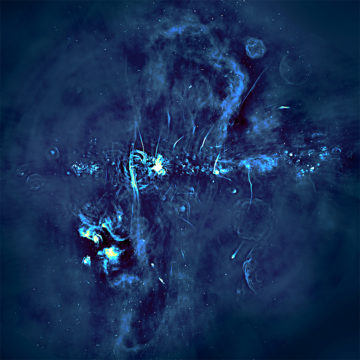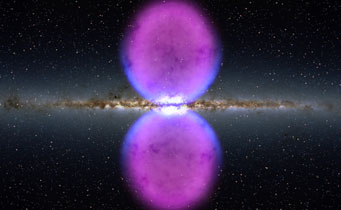Two studies support the suspicion that our galaxy’s black hole had one or more outbursts a few million years ago.
By cosmic standards, the Milky Way’s supermassive black hole is a lazy resident of a sleepy neighborhood. But not so long ago, our galaxy’s center was a happening place. A combination of star formation, radiation, and maybe even black hole flareups made for a raucous scene, one that left its mark across thousands of light-years.
Two new papers shed additional light on our galactic center’s tempestuous past. They explore vastly different scales, but they both point to a similar history.

SARAO / adapted from Heywood et al. / Nature 2019
In the first study, Ian Heywood (University of Oxford, UK) and colleagues used a new radio mosaic from the MeerKAT radio telescope array in South Africa to find a pair of outflows emanating from the galactic center — one reaching above, the other below, the Milky Way’s disk. The team calls it a bipolar bubble structure, but frankly to my eyes it looks more like a tooth with its root, the gumline marked by the galactic disk. Astronomers had already seen the northern lobe in 1984, but they hadn’t picked out the entire structure.
These radio lobes are a much smaller version of the Fermi bubbles, the gigantic dumbbell sticking above and below the galactic center that end to end stretches some 50,000 light-years. The MeerKAT lobes are a wee 1,400 light-years long in comparison, and they took something like a thousandth as much energy to inflate as the Fermi bubbles did.
Whatever blew the MeerKAT bubbles, the event accelerated a bunch of electrons. These are corkscrewing along magnetic field lines to produce the radio glow MeerKAT detects. Based on the particles’ properties, the researchers estimate that the event happened a few million years ago — similar to the age of the Fermi bubbles if we assume they were inflated by an outburst from the black hole and not the built-up effect of a burst of star formation.
Perhaps, the authors speculate in the September 12th Nature, the MeerKAT event was a mini version of whatever made the Fermi bubbles. Or, several events like the MeerKAT one combined to make the larger structure.

Notably, the smaller lobes’ edges appear to line up with a number of nearby magnetized filaments, which have remained a mystery since their discovery 35 years ago. “They represent one of those phenomena that the community sort of forgets about, simply because nobody has come up with a totally satisfactory explanation for them,” says Roland Crocker (Australian National University), who was not involved with the research.
The team thinks that the particles lighting up the MeerKAT lobes could also be what’s lighting up these enigmatic filaments. “To the extent that these MeerKAT observations shed new light on the filaments, they are certainly of great interest,” Crocker says.
A Raging Fit
Heywood’s team and Crocker are both rather circumspect when it comes to naming a culprit for these bubble structures. But in a separate galactic center study soon to be published in the Astrophysical Journal, Joss Bland-Hawthorn (University of Sydney, Australia) and colleagues choose a side: They think the black hole, Sgr A*, threw a fit several million years ago.
The Large and Small Magellanic Clouds are the biggest dwarf galaxies in the Milky Way’s neighborhood, and they’re currently on their first whiplash pass. Trailing from the dwarf galaxies is a long ribbon of gas called the Magellanic Stream. It passes beneath our galaxy’s south pole. In 2013, Bland-Hawthorn and others had found patches of hydrogen glowing brightly in the section of the stream over the pole and suggested the glow was due to a past blast of radiation from the black hole.

J. Bland-Hawthorne et al. / ASTRO 3D
The researchers have now added ultraviolet measurements of ionized hydrogen, carbon, and silicon in the stream to their analysis. These ions are in the same parts of the stream as the other hydrogen emission studied, tracing out a large segment. Hints of ionized clouds also appear in the northern hemisphere. Together, these patches seem to lie in the path of a wide hourglass, emanating from the galactic center.
The clouds are cooling now, and because the ions cool at different rates, the astronomers can use that to determine how long ago the event happened. “Imagine three kettles, one made of plastic, one of aluminium, one of gold,” Bland-Hawthorn explains. “They all switch off at the same time. You can come back at a later time, any time, with a thermometer and figure out when they all switched off.”
The team looked at a range of sources, how long they would take to ionize the gas, and how long they’d take to fade away. Young stars blazing to life in the galactic center can’t explain the glow, the astronomers conclude, nor can a smack from the expanding Fermi bubbles: The stream is simply too far away.
The only explanation they think plausible is that Sgr A* flared dramatically about 3½ million years ago. Either in one event or as a succession of smaller ones, gas dumped onto the black hole, and as it fell in it heated up so much that it lit up like a spotlight. The ultraviolet radiation from this blaze was so powerful that it then kicked electrons out of the atoms in the Magellanic Stream some 250,000 light-years away.
H.-Y. Karen Yang (University of Maryland) agrees the new ultraviolet data strengthen the case for a black hole flare. These data enable the team to estimate the energy required and how long ago the event happened in two independent ways, she explains. Although there’s still disagreement about the Fermi bubbles’ origin, the timing and energy are a good match for Sgr A* having some sort of tantrum.
And it’s not just the stream and the bubbles: a young cluster of stars huddled around the black hole also appears to be a few million years old. Astronomers think the cluster formed when a big cloud of gas invaded the black hole’s neighborhood, fragmenting into new stars. That scenario should sound familiar. It may well be that the Fermi bubbles, the central star cluster, and the ions in the Magellanic Stream are all relics of our black hole’s rollicking past.
References:
I. Heywood et al. “Inflation of 430-parsec bipolar radio bubbles in the Galactic Centre by an energetic event.” Nature. September 12, 2019.
Joss Bland-Hawthorn et al. “The Large-Scale Ionization Cones in the Galaxy.” Accepted to the Astrophysical Journal. Posted to arXiv.org October 5, 2019.
 0
0









Comments
You must be logged in to post a comment.